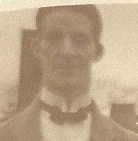Sjt
George Arthur Dawson
Information about birth
|
Year of birth: 1890 |
|
Place of birth: Prestwich, Lancashire, England, United Kingdom |
General information
|
Profession: Maker-up |
Army information
|
Country: England, United Kingdom |
|
Force: British Expeditionary Force |
|
Rank: Serjeant |
|
Service number: 251171 |
|
Units: — Manchester Regiment, 21st Bn. (6th City) (Last known unit) |
Information about death
|
Date of death: 24/10/1917 |
|
Place of death: Bass Wood, Geluveld, Belgium |
|
Cause of death: Killed in action (K.I.A.) |
|
Age: 27 |
Memorial
|
Tyne Cot Memorial Panel: 120 |
Distinctions and medals 2
|
British War Medal Medal — 30/01/1920 |
|
Victory Medal Medal — 30/01/1920 |
Points of interest 2
| #1 | Place of birth | ||
| #2 | Place of death (approximate) |
My story
George Arthur Dawson was born in 1890 in Nutfield, Lancashire, England and had been a Maker-up in a textile factory before the outbreak of the war. By October 1917 George Arthur Dawson served as a serjeant in the Manchester Regiment 21st Battalion, part of the 91st Brigade, of the 7th Division.
The 7th Division participated in the opening stage of the Second Battle of Passchendaele (26 October - 10 November 1917), the final push of the Third Battle of Ypres. On the 26th of October 1917 the 7th Division had to attack the ruins of the village of Geluveld. They were to cover the right flank of the Second Army’s front, which focused its advance on the Passchendaele ridge. Major General Shoubridge, commanding officer of the 7th Division, thought the attack to be suicidal, when he was notified of the plans. The Division had already tried to capture the village twice, but their attempts had been in vain. Shoubridge’s concerns were of course of no importance to the high command and the 7th Division would launch an attack on the heights of Geluveld on 26 October, making sure the Germans were occupied at Geluveld, in order to prevent them from reinforcing the Passchendaele Ridge.
After a short stay in billets in Northern France the 21st Manchesters returned to the frontline on the 22nd of October 1917. On the 24th of October the Battalion moved from Little Kemmel Camp, near the Kemmel Hill. They marched to the village of De Klijte, where the Battalion boarded busses, which took them to the vicinity of Lock 8 , at the Ypres-Comines Canal. The 21st left the area of Lock 8 at 5.15 p.m. and proceeded to their positions in Bas Wood and in Stout Wood, east of Bodmin Copse in the Bassevillebeek valley. The relief of the 39th Division passed of quietly and was completed by 11 p.m. The Battalion remained in their positions throughout the night and the following day. In anticipation of the attack on the 26th of October 1917 the 21st Manchesters suffered several casualties due to German shelling on their forward areas.
Serjeant George Arthur Dawson possibly fell victim due to German shellfire on Bas Wood in the night of 24 on 25 October 1917. The 27-year old has no known grave and is remembered on the Tyne Cot Memorial.
The 7th Division participated in the opening stage of the Second Battle of Passchendaele (26 October - 10 November 1917), the final push of the Third Battle of Ypres. On the 26th of October 1917 the 7th Division had to attack the ruins of the village of Geluveld. They were to cover the right flank of the Second Army’s front, which focused its advance on the Passchendaele ridge. Major General Shoubridge, commanding officer of the 7th Division, thought the attack to be suicidal, when he was notified of the plans. The Division had already tried to capture the village twice, but their attempts had been in vain. Shoubridge’s concerns were of course of no importance to the high command and the 7th Division would launch an attack on the heights of Geluveld on 26 October, making sure the Germans were occupied at Geluveld, in order to prevent them from reinforcing the Passchendaele Ridge.
After a short stay in billets in Northern France the 21st Manchesters returned to the frontline on the 22nd of October 1917. On the 24th of October the Battalion moved from Little Kemmel Camp, near the Kemmel Hill. They marched to the village of De Klijte, where the Battalion boarded busses, which took them to the vicinity of Lock 8 , at the Ypres-Comines Canal. The 21st left the area of Lock 8 at 5.15 p.m. and proceeded to their positions in Bas Wood and in Stout Wood, east of Bodmin Copse in the Bassevillebeek valley. The relief of the 39th Division passed of quietly and was completed by 11 p.m. The Battalion remained in their positions throughout the night and the following day. In anticipation of the attack on the 26th of October 1917 the 21st Manchesters suffered several casualties due to German shelling on their forward areas.
Serjeant George Arthur Dawson possibly fell victim due to German shellfire on Bas Wood in the night of 24 on 25 October 1917. The 27-year old has no known grave and is remembered on the Tyne Cot Memorial.
Sources 3
|
91 Infantry Brigade: 21 Battalion Manchester Regiment, (The National Archives, KEW (TNA), WO 95/1668/3). https://discovery.nationalarchives.gov.uk/details/r/C14303 Further reference |
|
McCarthy C., Passchendaele. The Day-by-Day Account, (London, Uniform, 2018), pg. 141-144. Sources used |
|
Stedman M., Manchester Pals 16th, 17th, 18th, 19th, 20th, 21st, 22nd + 23rd Battalions of Manchester Regiment: A History of the Two Manchester Brigades, (London, Leo Cooper, 1994), pg. 182-183. Sources used |
More information 3
|
Commonwealth War Graves Commission Database https://www.cwgc.org/find-records/find-war-dead/casualty-details/1629619 |
|
Namenlijst (In Flanders Fields Museum) https://namenlijst.org/publicsearch/#/person/_id=dab712bd-780d-49fe-a22c-29cd6715126a |
|
Lives of the First World War (Imperial War Museum) https://livesofthefirstworldwar.iwm.org.uk/lifestory/1146652 |
